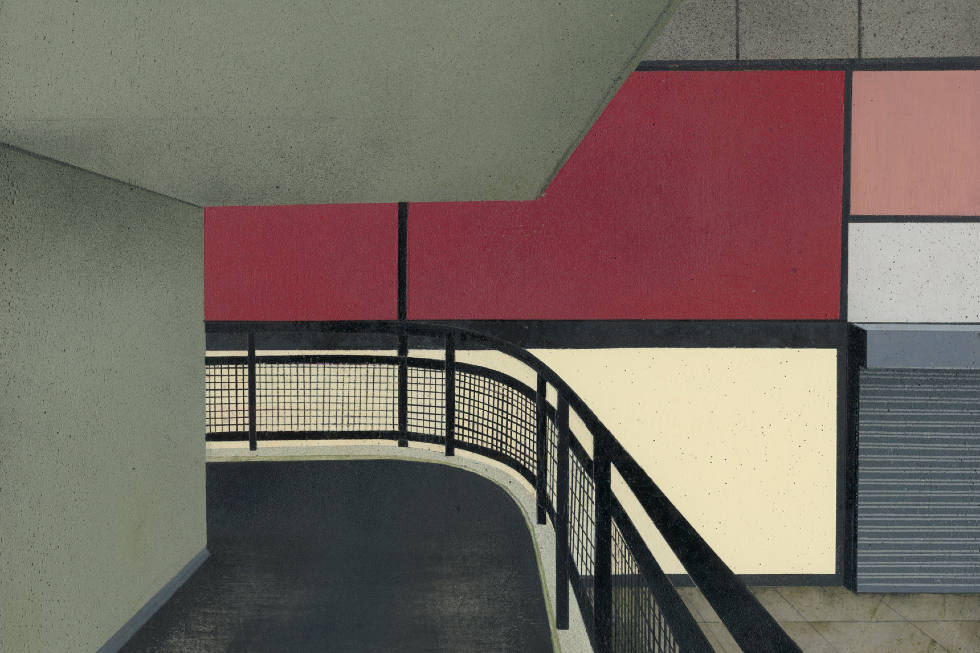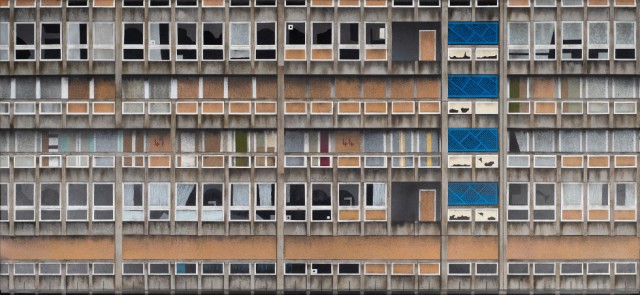“I have always loved Brutalist architecture” – Art & Politics With Mandy Payne

“Class and politics are inextricably bound up in architecture.” Inspired by modernist structures, social housing, gentrification and marginalised spaces, Mandy Payne has been documenting urban landscapes for the best part of a decade. Mike Pinnington spoke with the artist ahead of Brutal, a new exhibition foregrounding the built environment…
The Double Negative: When did you start making work like this and why?
Mandy Payne: My work is inspired by urban landscape, gentrification and marginalised, overlooked spaces. I am particularly interested in Brutalist, modernist structures and social housing. The work began as part of my final degree show for my part-time BFA at Nottingham University, where I graduated in 2013. I have always loved Brutalist architecture (my school was a concrete comprehensive on the outskirts of Bradford, built by the architects who designed the Barbican) and I am drawn to the sculptural qualities of such buildings, their monolithic scale, geometry, materiality, and rawness. During my art degree I began to focus on Park Hill, the iconic Grade II * listed Sheffield housing estate, which was just starting to be redeveloped. It was an interesting site to observe; a few of the original residents were still there, but most had already been decanted. I was particularly attracted to the old, un-regenerated parts of the estate where the memories and traces of past lives seemed almost tangible.
Fascinated not only by Park Hill’s aesthetics, but its social history, I became mildly obsessed with the place, taking thousands of photos, drawing in situ, like an unofficial artist in residence, wanting to document the changes afoot. In 2017 public access to Park Hill became increasingly restricted and I realised I needed to find a new muse. My son had recently moved to London, so I began to explore Stratford (where he lived), and similar estates/areas undergoing gentrification, often getting ideas for new locations to visit through reading and social media.
TDN: Can you talk a bit about your process – it seems like you do a lot of scouting, almost like a movie location scout?
MP: I do do a lot of scouting to make my work. I love walking and find this a great way to explore and get to know a place. If I find a location particularly inspiring (as I have with a few London estates which are currently being demolished), I will revisit at every opportunity, and make a series of works often over many years. I found making new paintings, from places where I had no direct connection with, strange at first and it felt especially important that I visit these new sites in person rather than relying on found photographs. As well as London, my explorations have taken me all over the country, including Manchester, Liverpool, Salford, Huddersfield, Coventry, and the North East. In photographing locations, I tend to just take quick snaps on my phone as I am mindful that I am often photographing people’s homes and I find my phone camera less intrusive. I then edit/crop the photos and make a detailed drawing which I transfer on to the concrete.

TDN: Tell us about the materials you use, and why you use them.
MP: I wanted to work with materials that were integral to sites I was depicting, namely concrete and spray paints (referencing graffiti). I cast the concrete myself into slabs and then paint directly onto the concrete surface, I build up the image in layers, isolating areas to spray paint with micro masking tapes and newspaper and then adding fine details with oil paint. My hand cast concrete paintings are quite small (15 – 30cm square) due to their weight. (I quite like this though as it gives them a feeling of intimacy, even domesticity, and is in complete juxtaposition to the sites they depict).
More recently (as in Remnants Of A Welfare State, above, currently on display in the John Moores Painting Prize) I have been working on some custom-made glass fibre reinforced concrete panels sourced from a local concrete company, which are much lighter than my home-made versions and have enabled me to work on a much larger scale. I have also been working on marble (referencing the perceived inequalities of rival building materials) using spray paint and oil again as the paint mediums.
TDN: Can you talk about the politics of the work?
MP: There is an underlying socio-political narrative to my works, indeed class and politics are inextricably bound up in architecture. There is huge inequality within our society, of haves and have nots which has been even more magnified by COVID. The sites depicted in my work were built at a time when the welfare state provided, when good housing was seen as an investment for all society and a basic human need. Neoliberal gentrification of our towns and cities has led to a chronic shortage in affordable housing, displacement of existing communities and to an ever-increasing homeless problem.
Art is a second career for me, before this I worked for 23 years as a Community Dentist in Rotherham, working with vulnerable adults and children in areas of high social need. A lot of my work involved domiciliary visits to estates and homes similar to the sites shown in my paintings. I think this job really shaped how I view the world and reinforced to me, the huge inequalities that are present in the UK today. These experiences definitely left a mark and have politicised my work and, although this might not be that overt, I try to select my titles carefully to contextualise and give a nudge to the underlying socio-political discourse.

TDN: To what extent are your paintings a lament for or celebration of the failed social and architectural experiments from which such housing arose?
MP: I think it is both, often depending on the sites depicted. The egalitarian aspirations of post war housing (as in the architect Berthold Lubetkin’s quote “nothing is too good for ordinary people”), should be celebrated, but so often mistakes were made. Be it by design (fostering crime), high rise builds, lack of individual outside space, poor building materials; then, during the late 70s and 80s, the corrosive nature of social and economic changes (Thatcher’s ‘right to buy’ policies, inadequate maintenance and investment together with high unemployment) led to the managed decline of many estates.
TDN: You only very rarely spot human figures in the paintings – what’s the thinking behind this choice?
MP: I like to focus on the buildings themselves and their sculptural/haptic qualities, although I occasionally leave a trace of human presence within the works, e.g., washing on the line, flowers in a window, graffiti tag.
TDN: Given you’re regularly responding to Brutalist buildings, the results could be confused for abstract artworks (e.g., Urban Geometry I, top). Is this a coincidence, or conscious outcome, one putting you in conversation with geometric abstraction and modernism more broadly?
MP: I came across a quote by the contemporary painter Paul Winstanley recently, which really resonates with me and, I think answers this question perfectly: ”It is impossible to make paintings of any sort now without an internalised vocabulary of twentieth-century abstraction.” For me, formal modernist qualities of colour, composition and perspective are important, and although my work is highly representational, I am drawn to abstraction and I am always looking to include such elements within the work, finding spaces within spaces, complementary horizontals, diagonals, and verticals, so I guess it’s a conscious outcome.
TDN: Is this documenting of gentrification and inequality an ongoing, long-term project, of yours?
MP: Absolutely! I really enjoy making these paintings and still feel I have many places left to explore and to take the work further.
As told to Mike Pinnington
Images, from top: Urban Geometry I; Remnants Of A Welfare State; For The Many Not The Few. All images by and courtesy of Mandy Payne. See more of Mandy’s work





